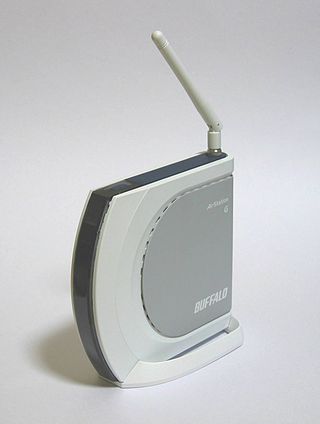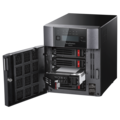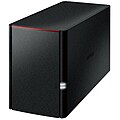
IEEE 802.11 is part of the IEEE 802 set of local area network (LAN) technical standards, and specifies the set of medium access control (MAC) and physical layer (PHY) protocols for implementing wireless local area network (WLAN) computer communication. The standard and amendments provide the basis for wireless network products using the Wi-Fi brand and are the world's most widely used wireless computer networking standards. IEEE 802.11 is used in most home and office networks to allow laptops, printers, smartphones, and other devices to communicate with each other and access the Internet without connecting wires. IEEE 802.11 is also a basis for vehicle-based communication networks with IEEE 802.11p.

AirPort is a discontinued line of wireless routers and network cards developed by Apple Inc. using Wi-Fi protocols. In Japan, the line of products was marketed under the brand AirMac due to previous registration by I-O Data.

Wi-Fi is a family of wireless network protocols based on the IEEE 802.11 family of standards, which are commonly used for local area networking of devices and Internet access, allowing nearby digital devices to exchange data by radio waves. These are the most widely used computer networks, used globally in home and small office networks to link devices and to provide Internet access with wireless routers and wireless access points in public places such as coffee shops, hotels, libraries, and airports to provide visitors.

The AirPort Extreme is a residential gateway combining the functions of a router, network switch, wireless access point and NAS as well as varied other functions, and one of Apple's former AirPort products. The latest model, the 6th generation, supports 802.11ac networking in addition to older standards. Versions of the same system with a built-in network-accessible hard drive are known as the AirPort Time Capsule.
IEEE 802.11n-2009, or 802.11n, is a wireless-networking standard that uses multiple antennas to increase data rates. The Wi-Fi Alliance has also retroactively labelled the technology for the standard as Wi-Fi 4. It standardized support for multiple-input multiple-output, frame aggregation, and security improvements, among other features, and can be used in the 2.4 GHz or 5 GHz frequency bands.
Qualcomm Atheros is a developer of semiconductor chips for network communications, particularly wireless chipsets. The company was founded under the name T-Span Systems in 1998 by experts in signal processing and VLSI design from Stanford University, the University of California, Berkeley, and private industry. The company was renamed Atheros Communications in 2000 and it completed an initial public offering in February 2004, trading on the NASDAQ under the symbol ATHR.

The Nintendo Wi-Fi USB Connector is a wireless game adapter, developed by Nintendo and Buffalo Technology, which allows the Nintendo DS, Wii and 3DS users without a Wi-Fi connection or compatible Wi-Fi network to establish an Internet connection via a broadband-connected PC. When inserted into the host PC's USB port, the connector functions with the Nintendo DS, Wii, DSi and 3DS, permitting the user to connect to the Internet and play Nintendo games that require a Wi-Fi connection and access various other online services. According to the official Nintendo website, this product was the best-selling Nintendo accessory to date on 15 November 2007, but was discontinued in the same month. On September 9, 2005, Nintendo announced the Nintendo Wi-Fi Network Adapter, an 802.11g wireless router/bridge which serves a similar purpose.

The Buffalo TeraStation network-attached storage series are network-attached storage devices.
A wide variety of different wireless data technologies exist, some in direct competition with one another, others designed for specific applications. Wireless technologies can be evaluated by a variety of different metrics of which some are described in this entry.

A wireless repeater is a device that takes an existing signal from a wireless router or wireless access point and rebroadcasts it to create a second network. When two or more hosts have to be connected with one another over the IEEE 802.11 protocol and the distance is too long for a direct connection to be established, a wireless repeater is used to bridge the gap. It can be a specialized stand-alone computer networking device. Also, some wireless network interface controllers (WNIC)s optionally support operating in such a mode. Those outside of the primary network will be able to connect through the new "repeated" network. However, as far as the original router or access point is concerned, only the repeater MAC is connected, making it necessary to enable safety features on the wireless repeater. Wireless repeaters are commonly used to improve signal range and strength within homes and small offices.
IEEE 802.11a-1999 or 802.11a was an amendment to the IEEE 802.11 wireless local network specifications that defined requirements for an orthogonal frequency-division multiplexing (OFDM) communication system. It was originally designed to support wireless communication in the unlicensed national information infrastructure (U-NII) bands as regulated in the United States by the Code of Federal Regulations, Title 47, Section 15.407.
IEEE 802.11b-1999 or 802.11b is an amendment to the IEEE 802.11 wireless networking specification that extends throughout up to 11 Mbit/s using the same 2.4 GHz band. A related amendment was incorporated into the IEEE 802.11-2007 standard.
IEEE 802.11g-2003 or 802.11g is an amendment to the IEEE 802.11 specification that operates in the 2.4 GHz microwave band. The standard has extended link rate to up to 54 Mbit/s using the same 20 MHz bandwidth as 802.11b uses to achieve 11 Mbit/s. This specification under the marketing name of Wi-Fi has been implemented all over the world. The 802.11g protocol is now Clause 19 of the published IEEE 802.11-2007 standard, and Clause 19 of the published IEEE 802.11-2012 standard.

Buffalo AirStation is the name given to a series of wireless LAN equipment sold by Buffalo Technology.

The AirPort Time Capsule is a wireless router which was sold by Apple Inc., featuring network-attached storage (NAS) and a residential gateway router, and is one of Apple's AirPort products. They are, essentially, versions of the AirPort Extreme with an internal hard drive. Apple describes it as a "Backup Appliance", designed to work in tandem with the Time Machine backup software utility introduced in Mac OS X 10.5.
Linksys manufactures a series of network routers. Many models are shipped with Linux-based firmware and can run third-party firmware. The first model to support third-party firmware was the very popular Linksys WRT54G series.
IEEE 802.11ac-2013 or 802.11ac is a wireless networking standard in the IEEE 802.11 set of protocols, providing high-throughput wireless local area networks (WLANs) on the 5 GHz band. The standard has been retroactively labelled as Wi-Fi 5 by Wi-Fi Alliance.
TamoGraph Site Survey is an application for performing Wi-Fi site surveys and RF planning. It supports 802.11ax, 802.11ac, 802.11n, 802.11a, 802.11b, and 802.11g wireless networks. TamoGraph is developed by TamoSoft, a privately held New Zealand company founded in 1998 that specializes in network analysis software.
IEEE 802.11ah is a wireless networking protocol published in 2017 called Wi-Fi HaLow as an amendment of the IEEE 802.11-2007 wireless networking standard. It uses 900 MHz license-exempt bands to provide extended-range Wi-Fi networks, compared to conventional Wi-Fi networks operating in the 2.4 GHz and 5 GHz bands. It also benefits from lower energy consumption, allowing the creation of large groups of stations or sensors that cooperate to share signals, supporting the concept of the Internet of things (IoT). The protocol's low power consumption competes with Bluetooth, LoRa, and Zigbee, and has the added benefit of higher data rates and wider coverage range.
IEEE 802.11ax, officially marketed by the Wi-Fi Alliance as Wi-Fi 6 and Wi-Fi 6E (6 GHz), is an IEEE standard for wireless local-area networks (WLANs) and the successor of Wi-Fi 5 (802.11ac). It is also known as High EfficiencyWi-Fi, for the overall improvements to Wi-Fi 6 clients in dense environments. It is designed to operate in license-exempt bands between 1 and 7.125 GHz, including the 2.4 and 5 GHz bands already in common use as well as the much wider 6 GHz band.






















